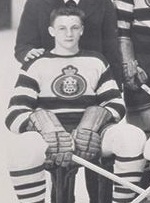Dickie Moore (ice hockey)
| Dickie Moore | |||
|---|---|---|---|
| Hockey Hall of Fame, 1974 | |||

Moore pictured c. 1948 with the Montreal Jr. Royals
|
|||
| Born |
January 6, 1931 Montreal, QC, CAN |
||
| Died | December 19, 2015 (aged 84) Montreal, QC, CAN |
||
| Height | 5 ft 10 in (178 cm) | ||
| Weight | 185 lb (84 kg; 13 st 3 lb) | ||
| Position | Left Wing | ||
| Shot | Left | ||
| Played for |
NHL Montreal Canadiens Toronto Maple Leafs St. Louis Blues AHL Buffalo Bisons |
||
| Playing career | 1951–1968 | ||
Richard Winston "Dickie" Moore (January 6, 1931 – December 19, 2015) was a Canadian professional hockey player, successful businessman and community philanthropist. He twice won the Art Ross Trophy as the National Hockey League's leading scorer and was inducted into the Hockey Hall of Fame. Moore spent much of his career with the Montreal Canadiens, but also played briefly with the Toronto Maple Leafs and St. Louis Blues. On January 1, 2017, in a ceremony prior to the Centennial Classic, Moore was part of the first group of players to be named one of the '100 Greatest NHL Players' in history.
Moore played left wing with the Montreal Canadiens from 1951 to 1963. He started playing with the Montreal Jr. Royals for three seasons from 1947 to 1950, and made his debut with the Montreal Canadiens in the middle of the 1951–52 season. Moore had played on two Memorial Cup winners, one with the Montreal Royals in 1949 and Montreal Junior Canadiens the following year. In the late 1940s Canadiens GM Frank Selke Sr. anointed him Canada’s best junior.
He was known for his hard accurate shot and his ability to stickhandle the puck. He twice won the Art Ross Memorial Trophy as the league's leading scorer. Moore broke Gordie Howe's record of 95 total points in a regular season play with 41 goals and 55 assists.
Moore won the Stanley Cup for the first time in 1953 and was a member of the Montreal Canadiens team that won five consecutive cups from 1956–60.
During his 1957-58 season with the Canadiens, Moore suffered a broken wrist during a collision with Detroit defenceman Marcel Pronovost which threatened to cut short a scoring championship year. Journalist Red Fisher described what happened next: Moore, the competitor, wanted to win the Art Ross. He had his eye on the prize, but Moore, the team man, had other ideas. One night, when the Canadiens were travelling on the train, he asked for a meeting with coach Toe Blake and his linemates, Maurice and Henri Richard. At the time, Henri was Dickie’s closest pursuer in the scoring race. Dickie told them he could still play with his wrist in a cast, but for how long? And as long as he played with an injury that would sideline most players, how much could he contribute to the line? “It’s not fair to Henri,” Moore told Blake. “It’s not fair not to allow him to win the scoring title.” The meeting lasted no more than a few minutes. It ended abruptly when Maurice and Henri told Blake: “There’s no damned way he’s going off the line.” Moore remained on the line. He played with his wrist imprisoned in a cast for the second half of the season. He won the Art Ross with an NHL-leading 36 goals and 48 assists in a 70-game season. Henri finished four points behind. Moore won it again in 1958-59 with 41 goals and 55 assists.
...
Wikipedia
